![]()
![]()
![]()
Use LEFT and RIGHT arrow keys to navigate between flashcards;
Use UP and DOWN arrow keys to flip the card;
H to show hint;
A reads text to speech;
76 Cards in this Set
- Front
- Back
|
What is a dystrophy? |
• Hereditary disorder • Disruption the function of a particular structure or tissue – Initially normal |
|
|
When is the function of a structure modified? |
Function modified when abnormal gene switched on
• Abnormal gene modifies one of the metabolic pathways of the tissue,– results in abnormal nutrition and tissue degeneration |
|
|
Where are rare recessive gene diseases more common? |
In small isolated populations |
|
|
Where/what can a dystrophy affect in relation to the eye? |
Typically affect the retinal pigment epithelium, photoreceptors or the choriocapillaris |
|
|
When can a dystrophy manifest? |
early childhood or later life |
|
|
Are dystropies bilateral? |
Usually bilateral and symmetrical |
|
|
How much of the UK population do eye dystropies affect? |
• Affect ~1 in 2,000 of the UK population
|
|
|
What percentage of all registwred severely sight impaired do dystophies account for? |
• Account for ~2 % of all registered severely sight-impaired |
|
|
What are dystophies usually associated with? |
Frequently associated with myopia and cataracts |
|
|
What is autosomal recessive? |
– Recessive gene carried in first 22 chromosomes – Both parents need to carry recessive gene – Both parents carriers if they do no show traits – Risk factor 25% – Variable expressivity – Generally earlier onset and more severe course |
|
|
What is autosomal dominant? |
– Dominant gene carried in first 22 chromosomes – Only one parent needs to carry gene – Gene is dominant – One parent will be affected – Risk factor 50% – Variable expressivity – Later onset and milder course |
|
|
What investigations should you carry out when presented with a possible hereditary disorder? |
• Full symptoms & history – Family history • Visual acuity • Pupil reactions • Visual fields – Amsler charts • Colour vision assessment • Dilated fundus examination |
|
|
Name some common Photoreceptor / RPE cell complex Dystrophies. |
• Retinitis Pigmentosa (RP) dystrophies • Leber’s amaurosis • Stationary night blindness • Cone dystrophies |
|
|
Name some Retinitis Pigmentosa (RP) dystrophies. |
– Purely ocular RP – Usher’s syndrome – Laurence-Moon Bardet-Biedl syndrome |
|
|
What is Retinitis Pigmentosa? |
• Progressive loss of photoreceptor (mainly rod) and RPE function - receptor/RPE cell metabolic complex affected.
• Most common hereditary retinal dystrophy |
|
|
What are the common features of Retinitis Pigmentosa? |
A group of diseases with the common features – Pigmentary retinal degeneration – Nyctalopia (night blindness) – Visual field defects |
|
|
What is the overall prevalence of Retinitis Pigmentosa? |
1 in about 5,000 |
|
|
What is the percentage of autosomal recessive Retinitis Pigmentosa? |
Autosomal recessive: 20-75 % – Can be severe |
|
|
What is the percentage of autosomal dominant Retinitis Pigmentosa? |
Autosomal dominant : 17-43 % -Least severe |
|
|
What percentage of Retinitis Pigmentosa is x linked recessive? |
X linked recessive: 8-18 % Most severe case |
|
|
With x linked recessive Retinitis Pigmentosa, when would you reach blindness? |
Complete blindness by 3rd to 4th decade |
|
|
With x linked recessive Retinitis Pigmentosa, What do female carriers show? |
Retinal signs |
|
|
What percentage of Ocular Retinitis Pigmentosa is sporadic cases? |
23% |
|
|
How long do sporadic cases retain central vision? |
Into 6th decade |
|
|
What are the symptoms Retinitis Pigmentosa? |
• Night blindness • Slow dark adaptation • Reduced peripheral field • Photopsia • Central visual loss late feature – Loss of cones – But cataract may affect it earlier |
|
|
What are the signs of Retinitis Pigmentosa? |
• Loss of contrast sensitivity – 1st • Visual acuity normal • Bilateral intraretinal mid-peripheral pigmentary changes • RPE atrophy • Tesselated fundus • Arterial attenuation • Optic disc pallor • Atrophy at the macula • Epiretinal membrane • Cystoid macula oedema |
|
|
What is seen at the macula of a female carrier of Retinitis Pigmentosa? |
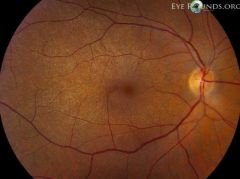
Tapetal sheen |
|
|
What is the visual field defect with Retinitis Pigmentosa? |
Progressive field defect – Partial or complete ring scotoma ~40-50° – Concentric reduction – Central island of vision • May be lost as well
•Nyctalopia |
|
|
What would happen to the colour vision of Retinitis Pigmentosa? |
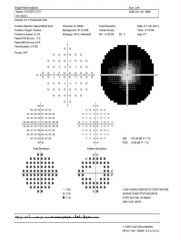
– Acquired type 3 (tritan) colour deficiency |
|
|
Around what age would X-linked R.P. be diagnosed? |
~4 years old in predisposed families, otherwise found by routine eye examination
Might see a ring scotoma |
|
|
What would be seen in the 1st Decade (0-10 years) of an X-linked R.P.? |
– Granular appearance of equatorial RPE – Retinal blood vessel attenuation – Temporal optic atrophy
• First symptom usually night blindness |
|
|
What would be seen in the 2nd Decade (11-20 yrs) of a X-linked R.P. px? |
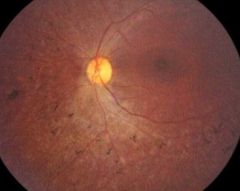
– Obvious RPE “bone corpuscle” clumps and RPE atrophy – Vascular attenuation – Progressive optic atrophy – Loss of some large blood vessels |
|
|
What are the symptoms in the 2nd Decade (11-20 yrs) of a X-linked R.P. px? |
• Severe night blindness • photophopia •mobility problems due to constricted field •↓ VA |
|
|
What would be seen the 3rd Decade of a X-linked R.P. px? |
– Pigment deposits at the posterior pole and throughout the retina – Optic disc has waxy pallor – Glassy macular reflex – Loss of large and small blood vessels – Unmasking of choroidal blood vessels – Posterior subcapsular cataract? – VA reduced to 6/36 - 6/60 – Tubular fields approximately 10 degrees |
|
|
What would be seen the 4th Decade of a X-linked R.P. px? |

– Severe retinal and choroidal atrophy – Severe atrerial attenuation – VA: CF or LP • Macula – Atrophic – Epiretinal membrane – CMO – Possible nystagmus – Cataract in 35% |
|
|
What are the ocular associations with Retinitis Pigmentosa? |
• Posterior sub-capsular cataract • Open-angle glaucoma • Myopia • Keratoconus • Vitreous changes – PVD – Uveitis • Optic disc drusen |
|
|
What is Usher’s Syndrome? |
Deafness and Visual Impairment |
|
|
What is the prevalence of Usher’s Syndrome? |
Overall prevalence 6.2 in 100,000 in UK population over 15 years |
|
|
What percentage of the young deaf population does ushers syndrome account for? |
3-6% of young deaf population |
|
|
Describe Type 1 Usher’s Syndrome? |
Most severe form – 75 % Autosomal recessive, profound congenital deafness, severe RP in first year |
|
|
Describe Type 2 Usher’s Syndrome? |
– 13 % Autosomal dominant |
|
|
Describe Type 3 Usher’s Syndrome? |
– 2 % Mild, late onset in the 3rd decade |
|
|
Clinical Course of Usher’s Syndrome |
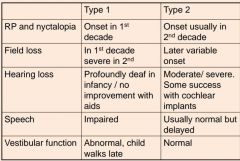
|
|
|
What is Bardet-Biedl Syndrome(Laurence Moon)? |
• Retinitis pigentosa combined with – Polydactly – Severe learning difficulties – Bull’s eye maculopathy – 80% have severe retinal changes by the age of 20 years |
|
|
What is Leber’s Congenital Amaurosis? |
• The earliest and most severe retinal dystrophy resulting in blindness in infancy.
First reported in 1869 |
|
|
How is Leber’s Congenital Amaurosis aquired? |
Inheritance : Autosomal recessive |
|
|
State the prevalence of Leber’s Congenital Amaurosis? |
• 3 in 100,000 • 10-20 % of child blindness, 5% of all inherited eye disease |
|
|
What are the clinical findings of Leber’s Congenital Amaurosis? |
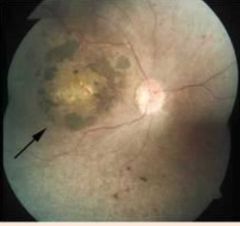
• Peripheral pigment stippling • Vessel attenuation • Hypoplastic disc • Wrinkled internal limiting membrane |
|
|
What does Leber’s Congenital Amaurosis lead to? |
• Leads to depigmentation, diffuse atrophy, multifocal pigmentary lesions at the posterior pole.
• Pupillary light reflex absent |
|
|
What are the two clinical forms of Leber’s Congenital Amaurosis? |
• Congenital or complicated • Juvenile or Uncomplicated |
|
|
Describe the Congenital or complicated form of Leber’s Congenital Amaurosis? |
– Visual impairment at 3 - 5 months – Photophobia, nystagmus – Poor pupil responses – Blindness in 1st year – Often fatal due to systemic complications |
|
|
Describe the Juvenile or Uncomplicated form of Leber’s Congenital Amaurosis? |
– Poor vision falling to 6/60 with nystagmus at 10 years – Hypermetropia and cataract in 50% – Retina initially normal - similar to RP by ~3yrs |
|
|
What are the signs and symptoms of cone dystrophy? |
– Poor VA, photophobia, poor colour vision and nystagmus |
|
|
What are the characteristics of cone dystophies? |
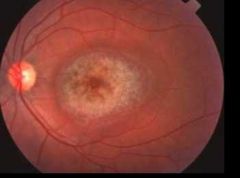
Characteristic “Bull’s eye” maculopathy. – Hyperpigmentation surrounded by rings of hypo and hyper |
|
|
What is Batten’s Disease? |
• A cone dystrophy
• The most common neurodegenerative disease in children and young adults worldwide
• Neurolipidosis – can be fatal |
|
|
What happens with Batten’s Disease? |
Lipopigments accumulate in neural, visceral and somatic tissue resulting in seizures, psychomotor deterioration and blindness |
|
|
Describe the Infantile type of Batten’s Disease. |
• Onset before 2 years – Rapid progressive psychomotor disorder – Abnormal gene on chromosome 1 – VA initially good |
|
|
Describe the Late infantile type of Batten’s Disease. |
• Onset 2-6 years – Abnormal genes on chromosome 11 or 15 – VA initially good |
|
|
Describe the Juvenile type of Batten’s Disease. |
• Onset 4-6 years – Typical “Bull’s Eye” macula. Poor VA – Widespread atrophy of the RPE – Progressive mental retardation – Death in 3rd decade – Abnormal gene on chromosome 16 |
|
|
Describe the Adult (Kuf’s disease) type of Batten’s Disease. |
– Pre-senile dementia – Mild “bull’s eye” macula. VA slightly affected |
|
|
Name some Retinal Pigment Epithelial Dystrophies. |
• Stargardt’s disease complex (fundus flavimaculatus). • Vitelliform dystrophies (Best disease). • Familial dominant drusen. |
|
|
What is Stargardt’s disease? |
The disease causes progressive damage or degeneration of the macula. |
|
|
State the prevalence of Stargardt’s disease. |
Prevalence : 1 in 10,000 |
|
|
How is Stargardt’s Disease aquired? |
Autosomal recessive (or dominant) |
|
|
What are the common features of Stargardt’s disease? |
• Yellow, concentric, sub-retinal flecks which stain with fluorescein – Similar to drusen but triangular
• Macular atrophy common – Reduced visual acuity |
|
|
Whatis the clinical course of Stargardt’s disease? |
• Onset in the 2nd decade
• Pigmentary macular degeneration
• Peripheral subretinal flecks - enlarged RPE cells filled with lipofuscin-like material
• Progressive diffuse atrophy of the RPE |
|
|
What is the colour visual function of Stargardt’s disease? |
• Colour vision : early onset of Type 1 red / green acquired deficiency similar to a congenital protan. |
|
|
What is the Visual acuity like with Stargardt’s disease? |
– Reduced in the 2nd decade – Severe progressive loss of VA - CF in the 4th decade. |
|
|
What would be seen on a visual fields plot with Stargardt’s Disease? |
central scotoma |
|
|
What appears with Familial Dominant Drusen? |
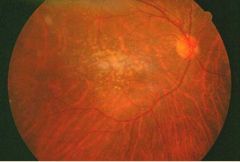
Drusen appear 2nd-3rd decades around macula and optic disc |
|
|
What is the visual function like with Familial Dominant Drusen? |
• Normal • Minority develop early ARMD |
|
|
What is Best Vitelliform Macular Dystrophy? |
An autosomal dominant genetic form of macular degeneration that usually begins in childhood or adolescence and slowly progresses to affect central vision. |
|
|
What would be seen at the macula with Best Vitelliform Macular Dystrophy? |
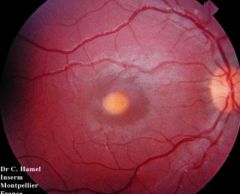
• Accumulation of yellow material beneath retina and RPE (esp.macula) • Occurs between 4 – 10 years of age • “Egg yoke” pattern at macula |
|
|
How is the vision affected with Best Vitelliform Macular Dystrophy? |
– Hyperopic shift (subjective) – Asymptomatic or slightly reduced VA |
|
|
What happens in the 2nd-4th decade of Best Vitelliform Macular Dystrophy? |
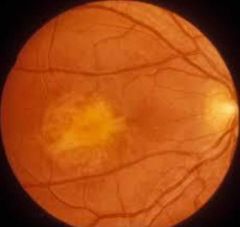
• Cyst collapses in – Material reabsorbed by the RPE giving pseudohypopyon then “scrambled egg” appearance |
|
|
What is the end stage of Best Vitelliform Macular Dystrophy? |
Atrophy of the RPE and disciform degeneration finally result with profound loss of VA. |

